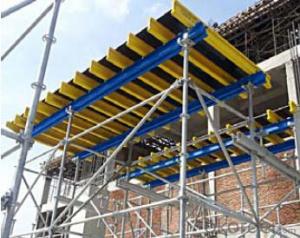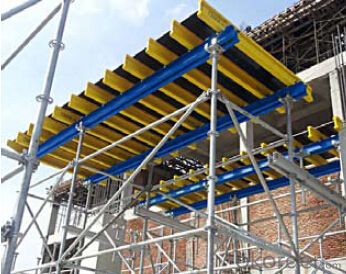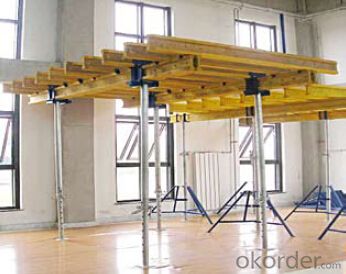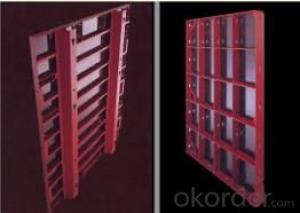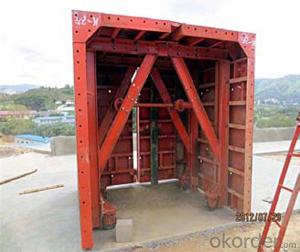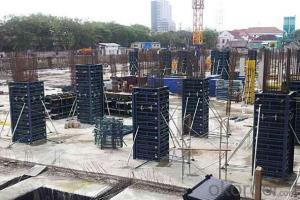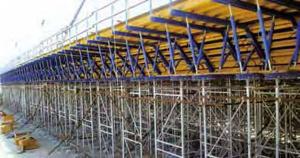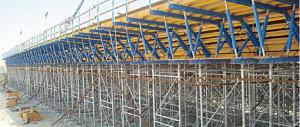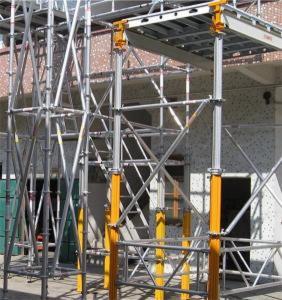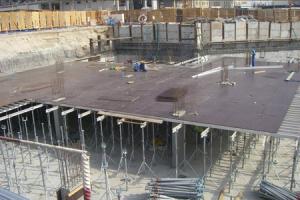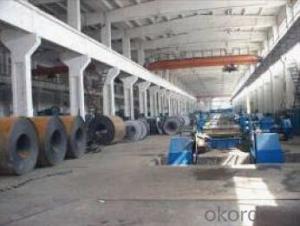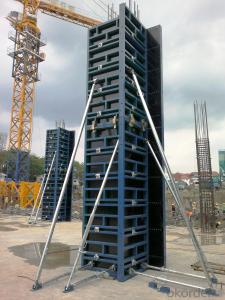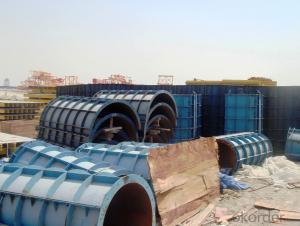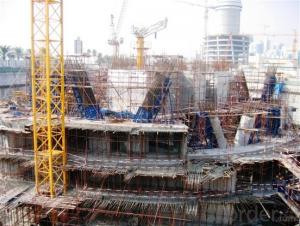Table formwork system and scaffolding system
- Loading Port:
- Tianjin
- Payment Terms:
- TT OR LC
- Min Order Qty:
- 50 m²
- Supply Capability:
- 1000 m²/month
OKorder Service Pledge
OKorder Financial Service
You Might Also Like
Tabel Formwork:
Table formwork is the most typical application for slab, with timber beam, the slab formwork is
light weight, fast and economic in the construction.
Characteristics:
◆ Simple structure, easy assembly.
◆ Flexible structure, be adapted to different support system.
◆ High construction efficiency with special system tools.
1. Lifting fork for lifting the table formwork to upper floor.
2. Trolley for moving the table formwork on floor.
◆ Flexible application with stand alone props.
◆ Safer condition with handrails.
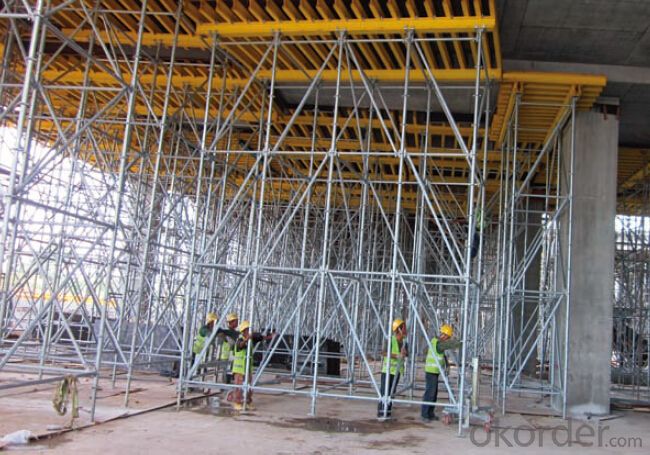
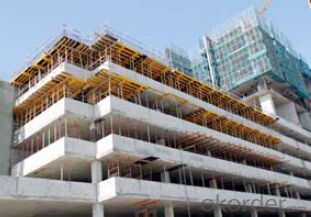
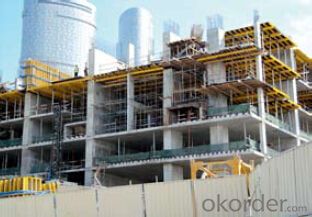
- Q: What are the different types of formwork release agents used with steel frame formwork?
- There are three main types of formwork release agents used with steel frame formwork: oil-based, water-based, and non-stick coatings. Oil-based release agents are commonly used and provide good release properties, but they can leave an oily residue on the formwork surface. Water-based release agents are environmentally friendly and easy to clean, but they may not provide as effective release properties as oil-based agents. Non-stick coatings, such as silicone or fluoropolymer-based coatings, offer excellent release properties and are durable, but they can be more expensive. The choice of formwork release agent depends on factors such as the desired release properties, ease of application, and environmental considerations.
- Q: How does steel frame formwork ensure proper concrete consolidation and compaction?
- Steel frame formwork ensures proper concrete consolidation and compaction by providing a rigid structure that holds the concrete in place during the pouring and curing process. The steel frame acts as a support system, preventing the concrete from sagging or deforming under its own weight. This ensures that the concrete remains in the desired shape and form, allowing for effective consolidation and compaction. Additionally, the steel frame formwork allows for the use of vibration equipment, which helps to further consolidate the concrete, removing any air voids and ensuring uniform compaction throughout the structure. Overall, steel frame formwork plays a crucial role in maintaining the integrity and quality of the concrete during the construction process.
- Q: What are the different types of climbing formwork systems used with steel frame formwork?
- There are several types of climbing formwork systems used with steel frame formwork, including crane-lifted climbing formwork, hydraulic climbing formwork, and self-climbing formwork. These systems allow for the vertical progression of the formwork, enabling construction workers to efficiently construct tall structures such as high-rise buildings and bridges.
- Q: Are there any environmental benefits to using steel frame formwork?
- Yes, there are several environmental benefits to using steel frame formwork in construction projects. Firstly, steel is a highly durable material that can be used repeatedly without losing its structural integrity. This means that steel formwork can be used for multiple construction projects, reducing the need for new formwork materials and minimizing waste generation. Additionally, steel frame formwork can be easily dismantled and reassembled, making it more versatile and adaptable for different construction needs. Furthermore, steel is a recyclable material, meaning that at the end of its life cycle, it can be recycled and used to produce new steel products. This reduces the demand for new steel production and the associated environmental impacts, such as mining and energy consumption. Moreover, steel frame formwork can contribute to energy efficiency in construction. Due to its superior strength and load-bearing capacity, steel formwork allows for the construction of more slender and lightweight structures. This leads to a reduction in the overall material used in construction, resulting in energy savings during the manufacturing, transportation, and installation processes. In conclusion, the use of steel frame formwork offers several environmental benefits, including durability, reusability, recyclability, and energy efficiency. By choosing steel frame formwork, construction projects can minimize waste generation, conserve resources, and reduce their environmental footprint.
- Q: How does steel frame formwork contribute to the overall quality of a concrete structure?
- Steel frame formwork is a construction technique that utilizes steel frames to support concrete structures as they are poured and cured, resulting in improved overall quality. To begin with, the use of steel frame formwork guarantees exceptional stability and rigidity, ensuring even and precise pouring of the concrete. The frames are designed to be robust and sturdy, minimizing any potential movement or deformation during the pouring process. This stability is vital in maintaining the structural integrity of the concrete, preventing the formation of cracks or inconsistencies. Furthermore, steel frame formwork allows for precise shaping and alignment of the concrete structure. The frames can be easily adjusted and aligned to accommodate any desired shape or design, ensuring that the final structure meets exact specifications and requirements. This precision is crucial in achieving a high-quality finish and an aesthetically pleasing appearance. Moreover, steel frame formwork facilitates efficient construction processes. The frames are lightweight and easy to handle, enabling quick assembly and disassembly. This speed and ease of use enhance the overall productivity of the construction project, resulting in faster completion times and reduced labor costs. Additionally, the reuse of steel formwork frames makes them a cost-effective solution for multiple projects, further enhancing their economic value. Additionally, steel frame formwork offers exceptional durability and longevity. The frames are constructed from high-quality steel, which is resistant to corrosion, weathering, and wear. This durability ensures that the formwork can withstand the pressures and forces exerted during the pouring and curing process, maintaining its structural integrity over time. As a result, structures built using steel frame formwork have increased longevity and require minimal maintenance or repairs. In conclusion, the utilization of steel frame formwork significantly improves the overall quality of concrete structures. Its stability, precision, efficiency, and durability all play a crucial role in ensuring accurate pouring, precise shaping, and long-lasting integrity. By incorporating steel frame formwork, construction projects can achieve high-quality, visually appealing, and durable concrete structures.
- Q: Does steel frame formwork require any special equipment for installation and removal?
- Special equipment is needed for the installation and removal of steel frame formwork. Cranes or hoists are often necessary to lift and position the steel frames. In addition, specialized tools like wrenches and spanners may be necessary to tighten the bolts and ensure a secure connection between the frames. To remove the steel frame formwork, cranes or hoists are also necessary to safely lift and remove the frames from the structure. In conclusion, proper equipment is essential to ensure the efficient and safe installation and removal of steel frame formwork.
- Q: How does steel frame formwork contribute to the overall sustainability of the built environment?
- Steel frame formwork contributes to the overall sustainability of the built environment in several ways. Firstly, steel is a highly durable material that has a long lifespan, meaning that steel frame formwork can be reused numerous times for different construction projects. This reduces the demand for new formwork materials and minimizes waste generation. Additionally, steel frame formwork is a versatile and adaptable solution that can be easily adjusted and modified to accommodate changes in design or construction requirements. This flexibility reduces the need for additional materials and resources, contributing to resource efficiency and reducing the overall environmental impact of the construction process. Moreover, steel is a recyclable material, meaning that at the end of its life cycle, the steel frame formwork can be recycled and used to produce new steel products. This helps to conserve natural resources and reduce the energy and emissions associated with the production of virgin materials. Furthermore, steel frame formwork offers a high level of precision and structural stability, resulting in efficient and robust construction. This reduces the risk of errors and failures during the construction process, leading to fewer material and resource wastages. The overall improved construction quality also enhances the longevity and performance of the built environment, minimizing the need for repairs and replacements in the future. Lastly, steel frame formwork can contribute to the energy efficiency of buildings. The lightweight nature of steel allows for the construction of thinner and more thermally efficient walls, reducing the energy consumption required for heating and cooling. This can result in reduced carbon emissions and lower energy costs throughout the lifespan of the building. In conclusion, steel frame formwork contributes to the overall sustainability of the built environment through its durability, reusability, recyclability, flexibility, and energy efficiency. By incorporating steel frame formwork into construction projects, we can minimize waste generation, conserve resources, reduce environmental impacts, and create buildings that are resilient, efficient, and long-lasting.
- Q: How does steel frame formwork prevent the formation of surface defects in the concrete?
- To ensure the smooth and accurate placement of concrete during construction, steel frame formwork plays a vital role in preventing surface defects. Firstly, it offers a stable and rigid structure that prevents any movement or shifting during pouring and curing. This stability allows the concrete to settle evenly, reducing the risk of cracks or unevenness. Secondly, the durability and resistance to deformation of steel frame formwork ensure it can withstand the pressure exerted by the concrete without bending or warping. This prevents any distortions that could lead to imperfections in the concrete. Additionally, the smooth and seamless design of steel frame formwork minimizes the chances of concrete leakage or seepage, which can cause honeycombing or voids. By containing the concrete effectively, it ensures a consistent and defect-free surface finish. Furthermore, steel frame formwork allows for precise control over the pouring process, easily adjusted and leveled for accurate placement and uniform thickness. This precision prevents unevenness or irregularities, resulting in a smoother and more aesthetically pleasing end product. In conclusion, steel frame formwork maintains stability, durability, smoothness, and precision to prevent surface defects in concrete, resulting in a high-quality finish without imperfections.
- Q: Can steel frame formwork be used for both monolithic and composite concrete structures?
- Steel frame formwork is suitable for both monolithic and composite concrete structures. This adaptable formwork system can be customized to fit various types of concrete structures. When constructing monolithic structures, the steel frame formwork acts as a temporary mold or framework. It supports the wet concrete until it cures and gains enough strength to support itself. This formwork system is commonly utilized in building walls, columns, and slabs, among other structures. In composite structures, the steel frame formwork is also employed, but with an added layer of reinforcement embedded within the concrete, such as steel bars or mesh. This reinforcement enhances the structure's strength and durability. Composite structures are frequently found in bridges, high-rise buildings, and other heavy-duty applications where increased load-bearing capacity is necessary. Using steel frame formwork offers numerous advantages for both monolithic and composite structures. It provides a sturdy and rigid support system during construction, ensuring precise and accurate concrete placement. Moreover, steel formwork is highly durable and can be reused multiple times, making it a cost-effective choice. Additionally, its modular design facilitates easy assembly and disassembly, saving time and labor on-site. In conclusion, steel frame formwork is a dependable and versatile solution for successful construction projects involving both monolithic and composite concrete structures. It provides the essential support and strength required for the completion of such projects.
- Q: How does steel frame formwork contribute to the overall structural integrity of a building?
- There are several ways in which the structural integrity of a building is enhanced by steel frame formwork. Firstly, the concrete pouring and curing process is supported by a strong and durable steel frame. This ensures that the formwork maintains its shape and can withstand the pressure exerted by the wet concrete. By preventing any distortion or deformation of the formwork, the concrete is poured accurately and evenly, resulting in a consistent and robust structure. Furthermore, precise alignment of the concrete elements is made possible by steel frame formwork. The steel frames can be easily adjusted and leveled, ensuring that the concrete is poured in the desired position and alignment. This is essential for maintaining the structural integrity of the building, as any misalignment or unevenness may compromise load-bearing capacity or create weak spots. Additionally, steel frame formwork offers excellent reusability and durability. Unlike traditional timber formwork, steel frames can be used repeatedly without deteriorating or losing strength. This not only saves costs and reduces waste but also ensures that the formwork remains structurally sound throughout multiple construction cycles. The durability of steel frame formwork contributes to the long-term stability and integrity of the building, as it can withstand various loads and environmental conditions without compromising its structural performance. Moreover, steel frame formwork allows for efficient construction processes. The modular design of the steel frames enables quick assembly and disassembly, reducing construction time and labor costs. This efficiency in construction contributes to the overall structural integrity of the building, as it minimizes the chances of errors or delays that could potentially compromise the structural strength. In conclusion, steel frame formwork plays a crucial role in enhancing the overall structural integrity of a building. Its robustness, precise alignment, reusability, durability, and efficiency contribute to the accurate and consistent pouring of concrete, ensuring a strong and stable structure that can withstand various loads and environmental conditions.
Send your message to us
Table formwork system and scaffolding system
- Loading Port:
- Tianjin
- Payment Terms:
- TT OR LC
- Min Order Qty:
- 50 m²
- Supply Capability:
- 1000 m²/month
OKorder Service Pledge
OKorder Financial Service
Similar products
Hot products
Hot Searches
Related keywords
